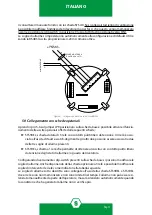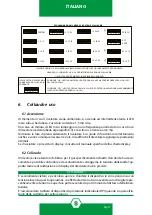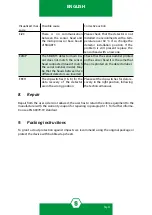
ENGLISH
Pag. 25
3.4 Precautions based on the gas to detect and environmental inhibitors
When preparing the installation site, it is necessary to take into account the nature of the gas
to be detected and the presence of chemical agents in the environment
³
All of the gases lighter than air (Methane, Hydrogen, Ammonia) tend to spread
upwards; the detector should be placed at 30 cm from the ceiling in order to maximise
the effectiveness of the detection. All of the gases heavier than air (LPG, Butane, Petrol
Vapours) tend to spread downwards; the detector should be placed at 30 cm from the
floor.
³
Catalytic sensors (Pellistors) offer excellent output linearity up to 100% LFL and have
an estimated lifetime of 4 years. Catalytic sensor performance may be altered by the
presence of some substances that, when present in the atmosphere being analysed,
can considerably change the response of the sensor and even damage it irremediably.
The presence of inhibitors or poisons is the most common cause of problems in the
gas detection and, for this reason, it is necessary to pay attention in order to avoid any
contamination. Among the most common poisons or inhibitors we can list silicones,
tetraethyl lead, sulphurous compounds (hydrogen sulphide), chlorinated compounds
(carbon tetrachloride), trichloroethylene and halogenated hydrocarbons. These com-
pounds do not affect the Infrared sensor, which find a suitable application whenever
a flammable gas is to be detected in environments where Pellistor cannot work. This
new technology has undoubted advantages such as lower dependence from environ-
mental factors (temperature and humidity and the non “poisoning”. Infrared sensors
estimated lifetime is 4 years.
Do not use gas detectors in atmospheres with a oxygen concentration greater than 21%.
4. Special conditions for safe use
³
Installation, use, maintenance and repair of the equipment must be carried out in ac-
cordance with these safety instructions provided by Sensitron.
³
The gas detector installation must guarantee the equipotential connection of the en-
closure.
³
The limits of the operating temperatures of the detector are shown on the label. They
are compatible with the limit temperatures of the sensor elements used inside the
sensor head.
WARNING!
Summary of Contents for SMART3G-GrI
Page 43: ...ENGLISH Pag 39...
















































